|
|
Post by 4real on Dec 23, 2011 14:53:04 GMT -5
Thanks again...
Yes, I did think that about the S/P switch and tested it and it indeed seemed to read correctly...but I am not convinced, so will take that apart and see how it reads completely disconnected from all switches.
The magnet too....it is an old pickup, but should not have lost any magnetism surely LOL....hence a comparison with another to see.
I'll compare the magnetism with a screwdriver too...right now...well, that's a bit vague, it sticks and feels slightly weaker, but very hard to tell anything conclusive with that...it does seem to be that kind of thing though....hmmm...
By disconnecting the pickup I can test the coils separately and see if that is ok just incas something has shorted inside that cover while building things...with the wires hanging out it could have got 'pulled' perhaps while moving it...all a bit odd...
It seems though you agree that there is no reason the mag should be so quiet on it's own buffer or no.
I've been fairly meticulous in the building of it and triple checked it...so perhaps I just need to separate out the 'problem' component starting with the pickup. I assume that the buffers are ok or no sound would pass.
The piezo is much louder and seems to be working ok, though still not as loud as I might have thought...harder to test out there. I am sharing power from it, but the extra buffers wouldn't hurt much and it would appear to be working ok.
It might well turn out to be something silly simple but obscure, so I think we all agree that there is something amiss in the HB side of things and one could expect that this guitar would be as loud as any other from the HB alone....so the problem must be there!
|
|
|
|
Post by reTrEaD on Dec 23, 2011 15:24:42 GMT -5
It might well turn out to be something silly simple but obscure, so I think we all agree that there is something amiss in the HB side of things and one could expect that this guitar would be as loud as any other from the HB alone....so the problem must be there! Any chance the two coils of the HB are out of phase with each other? |
|
|
|
Post by JohnH on Dec 23, 2011 15:27:51 GMT -5
The only things I can think of as a problem with buffers, whereby they might still work but give a very low output would be either.
1. the two resistors at the input being massively too low, like 33k instead of 3.3M, which would give it a low input resistance that would suck down the output of the pickup, as well as giving a dull sound.
2. also potentially related to the input resistors, the JFEt not getting biased correctly. Those circuits are fairly non critical, but with a 9V battery, you should have about 5 to 5.5V at the source (where the 33k resistor, the JFEt and the output cap meet), and outside of that anywhere from 4.5 to 6.5V should stillwork fine. Now you have three buffers engaged, you could compare this voltage for all three.
John
|
|
|
|
Post by 4real on Dec 23, 2011 16:53:00 GMT -5
Thanks John, they seem to be ok and well made...will test that...new battery as well and not a 'dull sound' so...suspect something obscure but simple going on, HB first... HB Phase, well no...I'd know that sound and the first I'd have suspected...as only the dark switch currently is having a noticeable effect, I might re think these switches, perhaps a local HOoP or something or a coil split (though I want to avoid noise problems)...but perhaps a lot of that is something to do with the HB. More likely one coil shorting out in the cover or something...so test it and if that is indicated, perhaps take it apart, again I think PITA, but seems the way to go.  An abstract photo of a boat at night at Christmas the other night... xmas eve here (I live in most people's future), so in case I miss it, warm wishes and much appreciation for the interest and invaluable help and suggestions on this project...I myself rescheduled the season, moving most forward a week, so I've already had xmas and so this is my new year and later in the month will plan a trip to catch up with others one on one...as I choose.
This year, I will be spending this weekend indulging in a lot of me time and summer splendour. For people in cold climbs, 31C here but thunderstorms on the way...with any luck, I might even solve this 'problem' and spend a lot of time playing the thing as my present to myself...best wishes... |
|
|
|
Post by 4real on Dec 23, 2011 23:42:53 GMT -5
OK....
So, something was wrong with the wiring, possibly the switch itself as it came apart when de-soldering (cheap, etc...) and so the series/parallel thing is now working as one would expect and the pickup sounds as one might imagine and much as I believe I had tested before.
Regardless...now the pickup is delivering as one might expect and with an output similar to that of say my HB tele...so that's a good thing.
The mix between piezo and blend is good...however...
Stereo is not quite working as I might hop. Switching the cable to the second output with nothing changed there, and turning teh blend/pan all the way over to that...the output is fairly 'dull' and less output...hmmm...odd. Almost like the volume it turned down without a treble bleed perhaps.
So...on the piezo output (also used as the blend out) and turning it to all piezo and switching between blend or stereo there is no difference...turning toward mag it works as a volume control to nil output...as one would expect from 'stereo' with decent separation (though I am not entirely sure that one would not want that slight boost on the end as one whole 'amp' is dropping out and so the volume perceived is less...no?)
The mag direct out though...hmmm
The second output (mag in stereo) is 'dull' when ever used with both blend (both signals) or stereo (mag only. If you plug into the 1st output (piezo in stereo) there is none of that in blend (nice bright strong signal) and no real change in volume or tone when the stereo switch is activated and the blend control all the way over to the piezio side...Good! However, the other output is dull (loss of highs and low in volume)
Any ideas? I checked the wiring and replaced anything that looked a bit 'suspect'. It is wired as drawn with two buffers off the volume control to out...
To me, does that only leave the buffer out on that channel to be 'suspect'? Is there any way to test if that is working on that channel?
When I turn to blend (so both systems out) the second output should be identical to the first and interchangeable, yes? Because it sounds completely different, even with the piezo with a similar system...
We are getting frustratingly close though...at least the HB mystery is solved and fixed and it is working well in 'blend' mode...we come a fair way with the power switching fixed as well (although, there is a 'skeetch kind of sound on inputting the jack, I assume when the hot tip hits the powered ground...I'll have to watch that!)
So as always, any ideas would help.
Once the thing is working, I can hot glue the buffers in place to avoid any further 'injury' as things are fragile every time the guitar has had to be moved wired like this particularly at in that area. I dare not drill into the guitar till it is complete and can't work on it installed anyway. The volume control is particularly weird with a big whole required unfortunately and I will need to grind down the holding nut for the knob to fit on!
again, many thanks...
|
|
|
|
Post by JohnH on Dec 24, 2011 1:15:22 GMT -5
wow! getting really close now!
So, are you saying that, in blend mode, when plugged into the piezo output only, you can get a good blend with good tone blending anywhere from full mag to full piezo? (please confirm carefully)
In blend mode, the two output buffers get their inputs shorted togther, so they should sound identical. If they do not, then it proves that the problem must be with the mag output buffer. Check its source voltage (see previous post), check for any wire whiskers across tracks etc, try connecting to the signal at the input of the mag output buffer and check it sound the same as that of the piezo output buffer.
John
Also, how is the master volume working? OK?
|
|
|
|
Post by 4real on Dec 24, 2011 4:15:42 GMT -5
Ok... Well, of course I checked the tracks and ran a knife along the gaps and such...seems ok and neat...components are all the same on all three (made at the same time and systematically..so that seems fine)... First question part A... blend... Yes, in 'blend mode' (not stereo) gives a good blend out of the piezo (#1 output) with the mag. The mag is silent (no hiss) but sounds nice and bright and so the buffer is having an effect there. The control runs pretty smoothly from one end to another, no dip in volume as you play across the strings. Note, interestingly, the phase switch has an effect now, subtle and omne sounds better, but could be useful so will be kept (it is hard to reach anyway)...dark switch makes for an interesting combo (it is a 33 cap to ground, might seems a bit 'extreme' like a 'woman tone' thing) mixing well with the piezo. The series parallel switch is now working, so a little lighter HB sound there, as wanted.part B... stereoSo, here we have problems...however, what does work... Staying in the #1 (piezo) jack, blend knob to full piezo...switching to stereo from blend is silent and hardly any perceivable change in volume or tone...as one would hope. Turning the knob to mag, the piezo fades to silence a little before the end of the pots travel (full mag) as one would expect and hope for. Now...same thing, but now plugging into jack #2... First Piezo in blend mode still...I assume that in blend mode that both outputs 1 & 2 are interchangeable and could run two amps... Ah, but they dont...so buffer problem there...hmmm... As you say...LOL Change to jack #2, nothing in #1... in blend, both P and Mag much quieter and duller in sound....same amp and settings, just switching outputs. Same applies to switching to stereo mode...duller/ very reduced sound of mag, fading to nothing with blend turned towards Piezo side. SImilar volume and tone between blend and stereo modes...but not a good one! Plugging in two amps, same results...the mag side much quieter and duller out of that output. ... Volume control... Seems to be working fine, similar fade out, possibly would have been better to be a linear model but that is unavailable and not bad. Pretty much silent by 5-6 on the dial, so works fast and so sensitive. Harder to make fine adjustments, quicker to do things like swells. Still, not much in the way of choice there. Both piezo and mag seem to react similarly. No 'loading' seems evident with the buffers in play. I would not advise others to go with this type of 'plastic pot' as the whole to drill is a monster and these compact knobs will not fit over the nut holding it on...I will attempt to grind off the excess on the nut, but it is not going to be easy and regardless, there will be a pretty big hole in it...grrr.... Ok...seem to be having trouble measuring this...power reads 8.56 volts coming out of the battery...so that is good and getting to the buffers. All buffers are identical, made of same components and at the same time, values look right and as some work, it is not a mix up there. Run between tracks and such...ok... STOP PRESS... Found it!!!  Ok...well, it was a multitude of connections all connected to the inputs of to the circuits and caused due to 'bad practice' on my part and some 'track damage' on the edges in the cutting of the boards. The result was that although all teh joins wer good and the circuits correct, at various time (largely due to moving things all the time with wies hanging out connected to heavy brass plates, etc..) I ahd soldered the inputs (power, ground and input and out) through the hole and to the outside of the track...the result were a few breaks in the track evidently, at the hole and across the track that were invisible. Joins looked good, track looked good, etc... When trying to work out the voltages I notice that the power was going in but could not get the other readings, or there was a little bit of voltage there (clearly something was getting across cause it was making some sound). I fixed it by re-soldering the connections on all buffers so that the wires are towards the interior of the circuit and bridge soldered more securely and seems to be working... REPEAT... SEEMS TO BE WORKING>>> So, no difference now between outputs in blend, no clicks or pops switching between modes of changes in volume...no ground loops between amps...just working. So, the 'faults' were certainly this, possible the HB but now I am wondering...it was probably worth swapping out the switch as it was destroyed in de-soldering so might have failed...excessive heat damaged it, however it should not have, I use a temperature control soldering station/pencil...so a weakness in these cheap switches..however, more care and these should be ok. They are flat actuated so give a nice tactile feel to them since they will need to be used entirely by feel. ... So...got there in the end and 'proved the design'... A huge thank you to John and all those interested in this guitar. I will likely install everything into the guitar later this evening or tomorrow and so have the guitar working for Christmas day...less than 4 hours away! I have a few other 'touches' to do...re-strutting the top raised the bridge and so the action and the only way to adjust that is to shim the neck...thank Leo for bolt on necks...try doing that with a conventional arch top! This might mean a bit of intonation adjusting as well. Might make a nicer looking truss rod cover as well though that is cosmetic of course. ... Finishing this part of the guitar though will allow me to get back to a practice regime and learn some new tunes on the familiar guitar and utilize some of it's unique features...however, it also leaves me free to look into the "Hex" system in earnest...I'm so hopeful I am fitting a dummy pot LOL. And, I have a new sustainer design, not for this guitar, but may well be of interest to many should that work well. Again, thanks and here is a picture in celebration!  |
|
|
|
Post by JohnH on Dec 24, 2011 4:57:56 GMT -5
Yay!! and Happy Christmas!
But what a journey though? but you have something unique there, so looking foward to hear about how it works for you in use, and maybe some clips?
cheers
John
|
|
|
|
Post by 4real on Dec 24, 2011 5:05:18 GMT -5
Again thanks and Yay indeed...I always suspected that the electronics side would be a hurdle, that's why it is in the wiring section LOL...it was more straight forward than I thought it might be. Will install things tomorrow and see what I can do to do some clips of course as well as pics. And yes, there is so many unique things about this guitar, the tuning system, the bridge, the plastic back, the bolt on neck on an acoustic and of course some very cool blend and true stereo sounds. I have already been playing it a bit and the stereo sound is huge...so yes, some finishing off and... Merry Christmas...I know what I got, a new unique and working guitar...just what I wanted, thank you!  |
|
|
|
Post by JohnH on Dec 24, 2011 17:51:22 GMT -5
‘Morning. Just waiting for family to get ready before setting off for brother-in-laws house. A day fiddling with guitars would seem like a better option.
Last tech thought on this project:
If the volume controls are turning down too fast, adding resistors from hot to centre lug really smooths them out, as in a treble bleed but no cap. It will give you a taper that is still log-ish, but more gradual. This will have no affect on tone, noise or distortion, and no effect at full volume, no eeffct on the balance of the pups. No adverse effect in stereo mode. There’s only one very small down-side. Currently, the blender (in blend mode) has almost constant volume as you sweep it, dipping in theory less than 1db at mid blend. If you do say a 220k resistor (or near to that - not critical) on each volume pot half, then, at low volume, it may dip about 1db further at mid blend.
So if the volume control action is important to you, this may be worth a try.
Cheers
John
|
|
|
|
Post by 4real on Dec 24, 2011 19:55:46 GMT -5
Thanks John I might give that a go if something is about and handy. There is a noticeable mid blend dip, but it is not drastic and acceptable. I might take today 'off' it is xmas day after all...but will install things perhaps tomorrow and take some pics and all. I am indulging myself and doing things on my own terms, but I might...might...if I chose take a trip off island overnight and give the GF and family a surprise there by making an unusual 'appearance'...if I feel so inclined later this evening. She does like to cook and a free meal is a free meal LOL. Otherwise, all quiet on the island and no hassles, just the way one would want it! Plenty of thunder and lightning about though over night and will come back later today and the next few days...good guitar tinkering weather... Was up a lot of the night trying to catch a few strikes from the veranda... 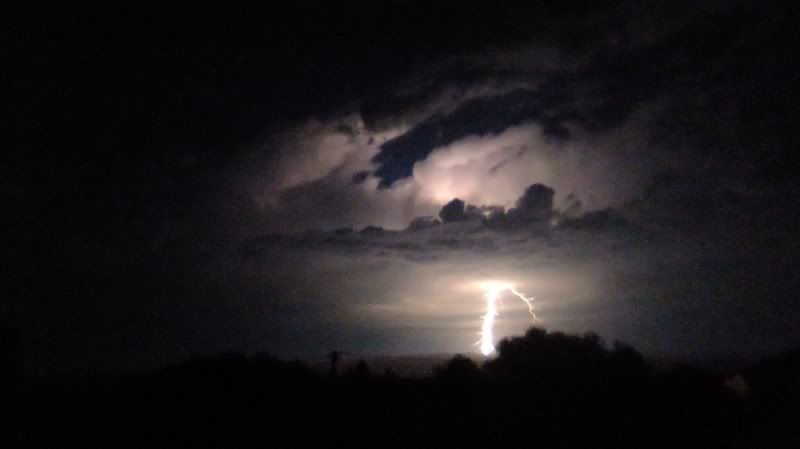 It is a great thing though that this project has overcome this hurdle and the 'stereo switch is pretty cool. I think all will be suitably impressed by the way these switches will look within the instrument and maintain a practical if slick look. I think the stereo switch opens up quite a few really interesting areas to explore...so many thanks for that side of things... The whole 'blend' thing is the ultimate 'tone control' with a huge variety of sounds available and the sound is somewhat unique. Everything from that kind of traditional jazz box sound to acoustic textures. A big variety of sounds that can be blended at will and textures that can be found by using unusual setting with the 4 band EQ. It is remarkably quiet, silent with the Mag and only a bit of hiss from the piezo if one turns up the treble or presence excessively. No feedback even at reasonably loud volumes. Not the acoustic sound of a 'flat top' really but then not the 'quack' typical of a piezo with the mag rounding things off to taste. The brass plates look good though will be completely hidden and the circuits will be protected from shorts and neatly 'hot glued' in place in edge...I think the results will be impressive to those that know what is in it. The 'hex ~ divided pickup' would be icing on the cake of course...that is the next 'project' I guess but have a good idea there to explore I think and quite a different 'solution' to that particular 'problem' though it could take a little while. Otherwise, I think it has been a very successful project so far and I was concerned that the whole thing might come undone if I failed to get the sound out of it that I envisaged...I mean, that is the point, it does not matter the 'features' or look if it does not sound right or plays in tune LOL. It could well change the kid of expectations I have for a guitar into the future and should be my main guitar now for a few years to come, it has capabilities that no other guitar comes close to and that is what really interests me in creating such things. Hopefully my technique will improve to make the most of it... Everyone enjoy the day, whatever you might do...and don't worry...there will still be more on this project for sure...it isn't over yet...  |
|
|
|
Post by 4real on Dec 25, 2011 21:54:53 GMT -5
OK...so finally found some time and concentration to do the installation..Ta-Dahhhh.... A glamour shot as a teaser... 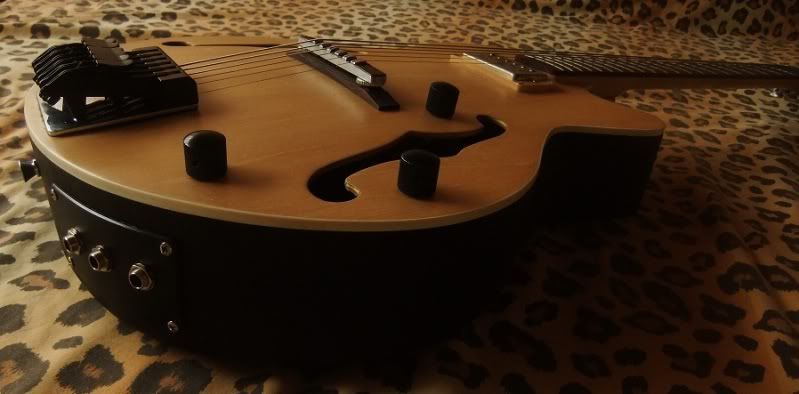 So...what I've done is tidy things up in the wiring and installed things... 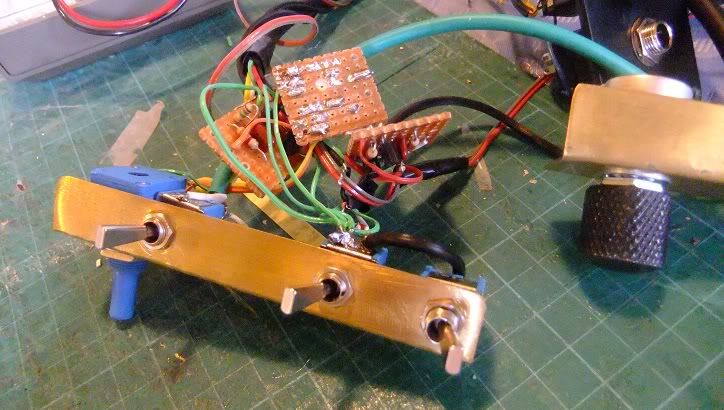 The working buffers all hanging loose and a proliferation of green ground wires on the "volume/HB control plate". 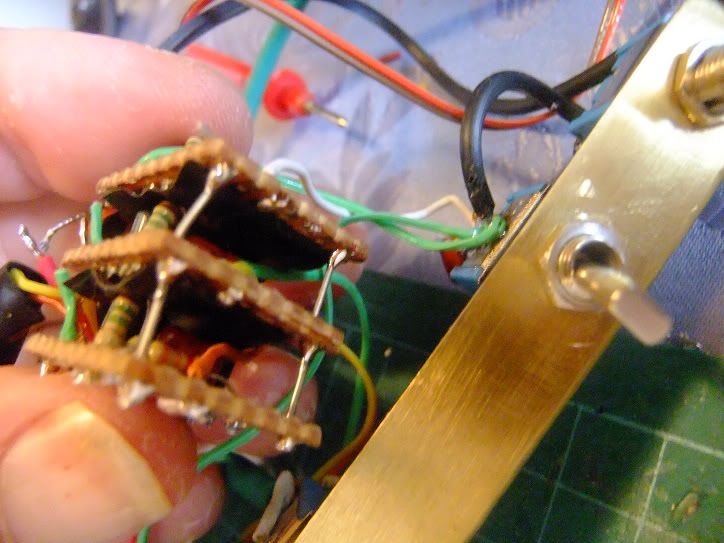 To make things neater and sturdier I thought to 'stack' the three buffers by soldering a solid wire between the power track and two on the ground track to make a cube. I placed PVC tape between the circuits to avoid possible shorting and on the brass plate where they will be mounted. With this configuration I can omit two ground and two power leads as they power off each other through the solid wire... 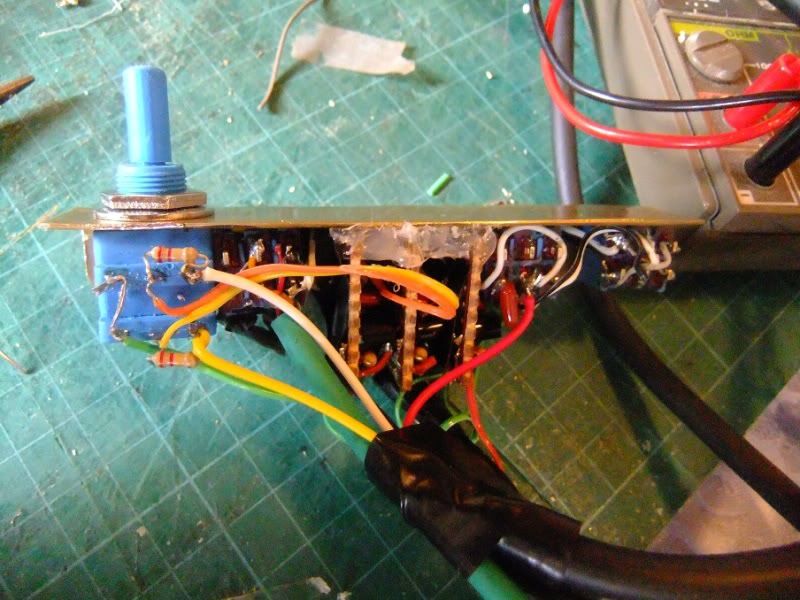 I added two 220K resistors as per john's last post in an attempt to make the volume a little more effective. It did this, but also put a more noticeable drop in the middle of the blend so, will leave it like this and see how I like it. I usually avoid 'hot melt glue' from a gun but it is ideal for this allowing the buffer 'cube' to be securely glued to the brass plate. I also glued the pots on carefully so they would not fall off when the nuts come off for the install. 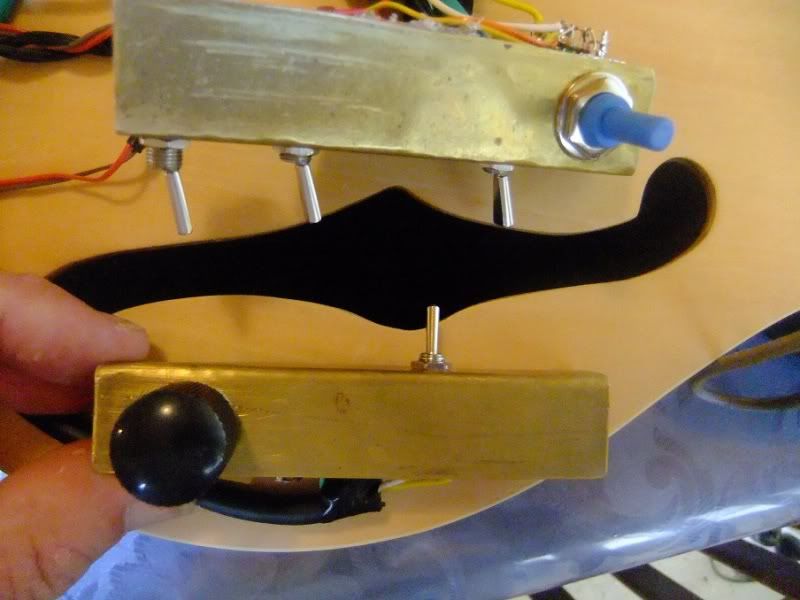 Above shows how I made the brass plate to fit and hold the switches out of sight. After the volume comes the series parallel switch, the 'dark' switch and the phase switch. On the other side, the blend with the blend/stereo switch showing through a little. The stereos switch moves up and down (due to the requirement for a 4pdt switch)...lifting up the switch goes to stereo so it could not be knocked by accident if being used in mono and potentially cutting out the guitar. 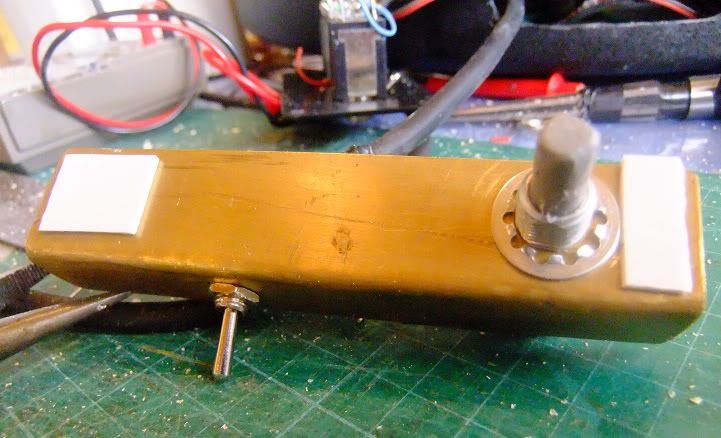 I put a couple of double-sided foam tape on the top surface so when installed it wont 'move'... 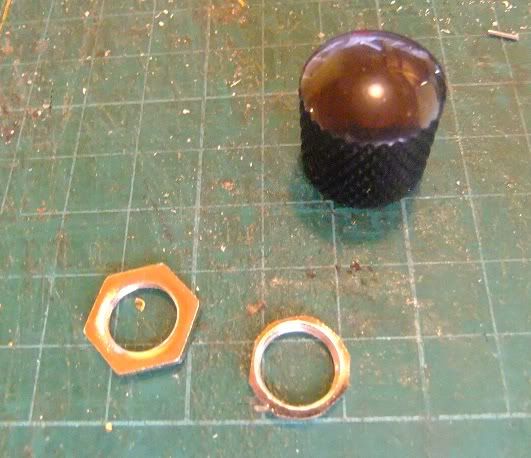 In order to make the volume control knob fit on the oversized pot, the nut needed to be significantly filed down so the knob will fit over and hide it...next to it is the original size.  Installed, the switches are well hidden from above and invisible but just within reach...I had to use a torch to get a shot of them, it's dark in there. 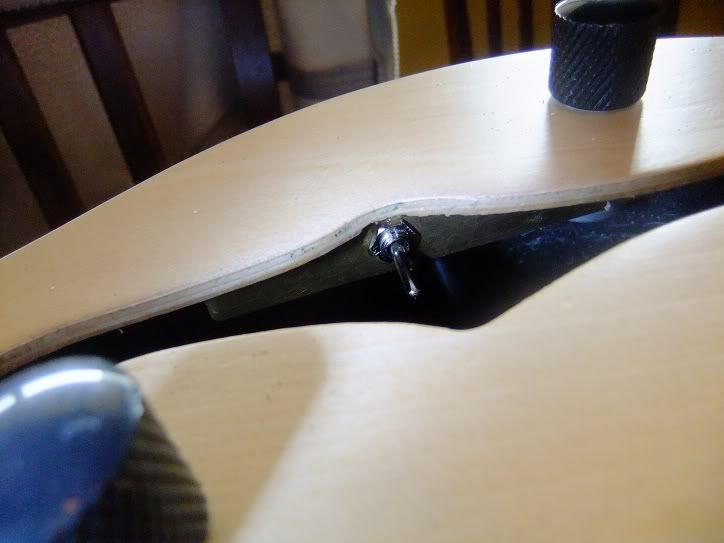 The stereo switch opposite. 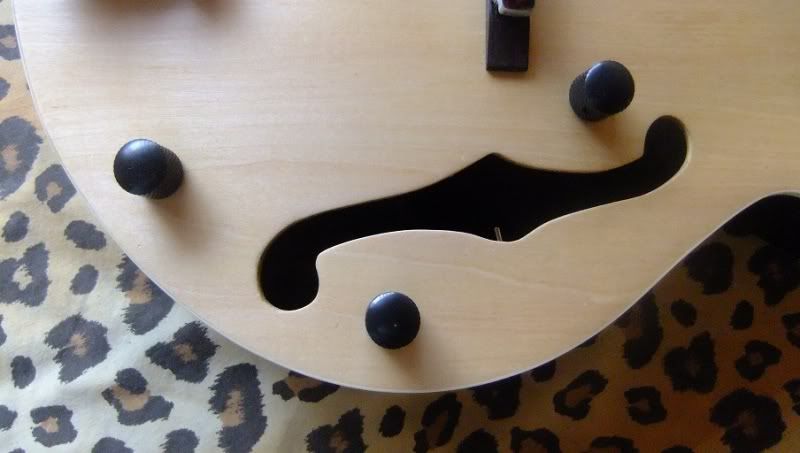 The end result, you can just see the stereo switch on the lower part of the F hole, but it never is above the F-hole and quite deep in there when in the default blend mode (ie, down). Not bad, eh? Following will be some more overall shots of the project to this stage...yes, I do sleep on leopard skin print sheets  |
|
|
|
Post by 4real on Dec 25, 2011 22:11:33 GMT -5
Ok, a few more 'overall glamour shots' of the project as she stands so far... 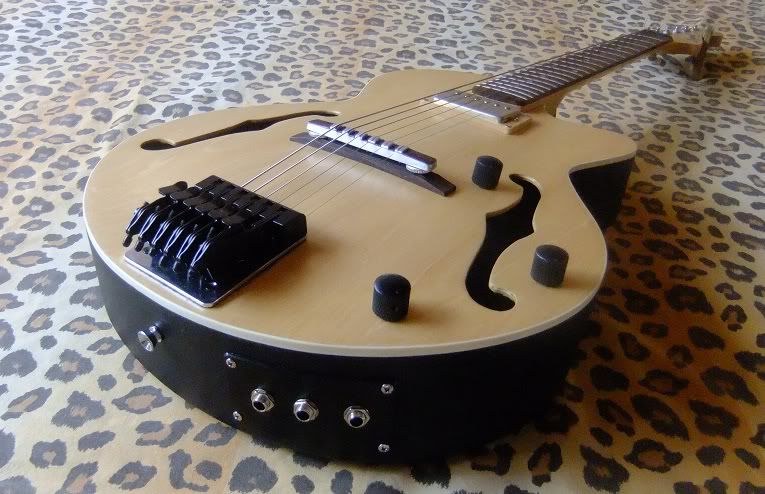 The trio of output jacks. The two lower are the piezo and mag (centre) in stereo or the same in blend...so you can plug it direct into two amps, effects chains, recording console, or PA channels. Other than the native blend between acoustic and mag sounds to two amps, one could also use this set up to run two effect chains and use the blend control to blend between quite different sounds...and so adjust effects. Say, delay on one side, blending that side out reduces the delay amount...or any effect you might choose. Similar with a pair of amps and any other one might choose. 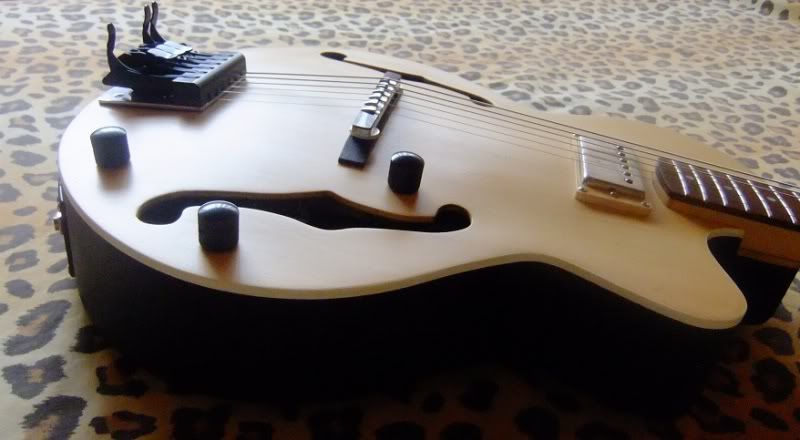 This shows a couple of the trilogy levers activated fully to got to 'open G' by lowering the E, A and E strings a tone. 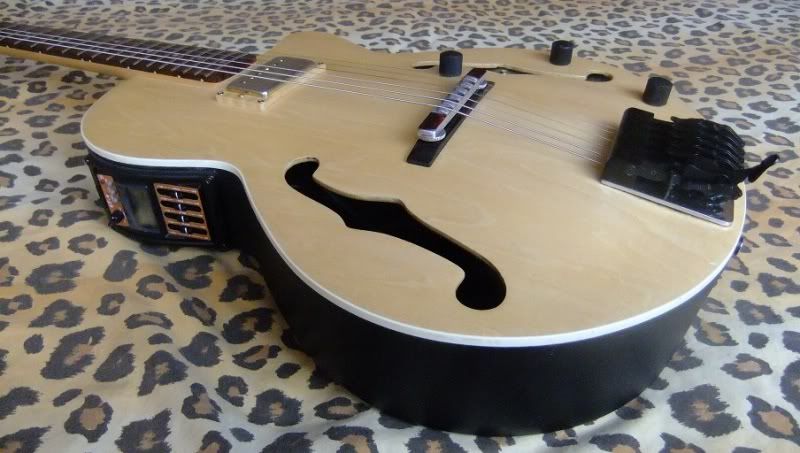 Here you can see the side EQ and tuner for the Piezo system Easy to forget it is there. It has its own volume control to adjust the balance with the mag and of course bass, middle, treble and presence to make for a heap of tone shaping...helps to make for a complementary tone with for the Mag. 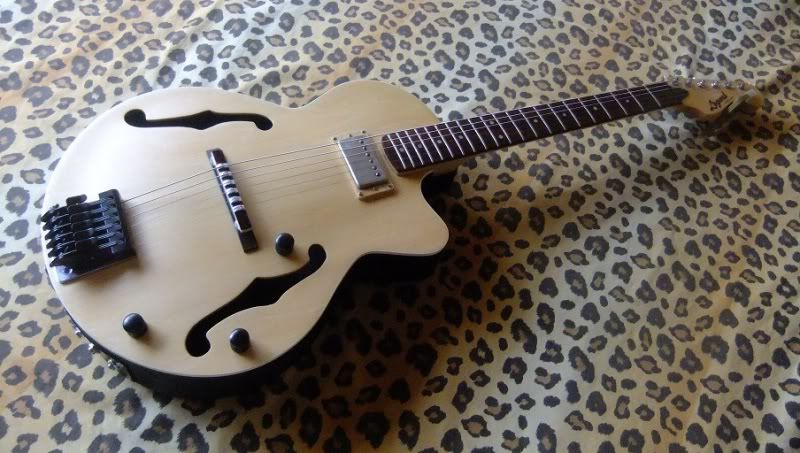 The whole guitar. Capo clamped out of the way on the head ready for use, the volume control close but out of the way and below the string hight, blend below the sound hole. The trilogy multi-tuning system, well fitted and working pretty well and neatly installed. I installed a 'dummy knob/pot' at the back in anticipation for the 'hex' device and the guitar becoming ... ummm ... Tri-phonic Again thanks for the encouragement and invaluable help... |
|
|
|
Post by cynical1 on Dec 25, 2011 23:06:37 GMT -5
I gotta toss a +1 out here. This has been one of the more detailed and episodic builds we've had here in my almost 4 years here.
The concept, the design and the cooperation among everyone here has been fantastic.
The next phase...the MIDI Years...will be something to look forward to.
I was intrigued by your idea of hiding the switches inside the f-holes. Now that I see it I take back any reservations I may have had.
Anytime you feel like tossing the random sound clip up that would be the icing on the cake.
Very nice, indeed.
Happy Trails -
Cynical One
|
|
|
|
Post by 4real on Dec 25, 2011 23:29:33 GMT -5
Thanks C1
Have not stopped playing it all arvo. Not fully convinced by the volume resistor mod, upsets the balance control a bit, but easily put back next time I get inside I guess...unless there is a better idea.
It has been a bit of a trip for sure. In case people have forgotten or not realized, this was done on the 'cheap' though costs strated to blow out when features were added I suppose. The body a plastic backed ebay 'toy' of a guitar, the old pawnshop prize neck was married to the body with mousetraps and tongue depressors.
The trilogy was expensive but Hipshot kindly gave me a generous 'builders discount' (on the strength of some of my other guitars (thanks hipshot, excellent service and product) and because it is an interesting project...possibly the first of it's kind to feature the trilogy on this kind of instrument.
The pickup is an original old Gibson, but a $10 sunday market thing that has been hanging around for a project like this. The piezo ebay, about $30. The tuners are locking and kind of necessary for the tuning system to be reliable.
So, very much a one of a kind guitar and many unique features that I hope will inspire others to draw from for ideas.
Special thanks of course to John...the wiring scheme finally worked out and I hope my execution does his work justice. The pre-amps are very impressive and as I have the parts to do more, intend to add one into my strat for sure. The guitar is as quiet as a mouse only having a little 'hiss' if one turns up the treble on the piezo and uses that alone.
There are still a few details yet to go. I want to shim the neck a little to lower the action a touch (raised when the top was 'put on stumps')...perhaps a few cosmetic things...seems a little odd to keep the "Legend" brand name on the headstock too, anyone any thoughts on that perhaps?
Otherwise a very special guitar for me in many, many ways and of course...the contributions of everyone here really made it...it helps to have an 'audience' so as to not cut corners and to see things through and the contributions have all been stellar and a tribute to the Nutz and this great little community. Even ideas I might not have used spur the imagination and it did draw on other aspects of other projects that have come before of course.
Again, sincere thanks...now...where was I on that 'divided pickup' again? Oh, and a new sustainer! Oh, add a pre-amp to the strat...check...
Clips when I can get around to it plus a gallery entry...busy playing guitar now...later...
|
|
|
|
Post by newey on Dec 25, 2011 23:40:52 GMT -5
This build has been an inspiration, both technically and for the thorough description of the process. The end result is very sanitary, your installation of the electronics so "stealthily" is terrific. +1!
|
|
|
|
Post by 4real on Dec 26, 2011 0:10:07 GMT -5
Thanks, much appreciated... Got the Nutz-i-ness without the obvious switches and a real tribute to this forum and what one can do, eh! 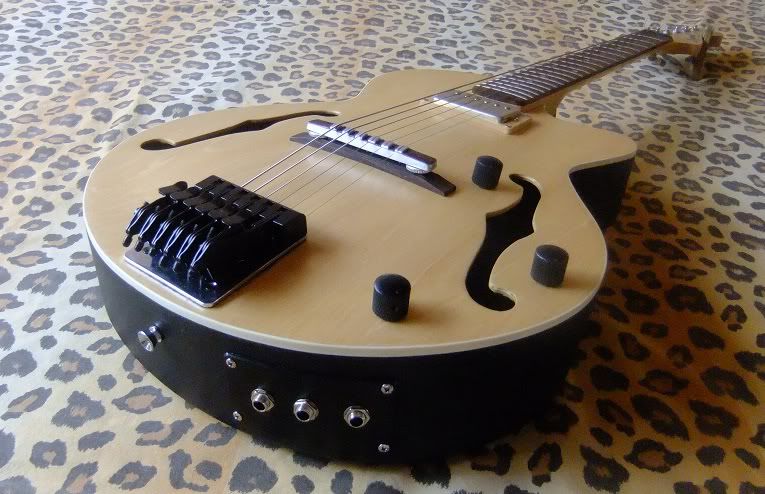 previous page for more pics and installation  plus, left in all my 'mistakes' which just goes to show that we all make a few and often they are many and hard to detect... I particularly liked my solution to the 'trilogy' thing by putting the top on stumps like that...guitars like this have a lot of pressure down on the top and can be slightly prone to feedback...this solved it all and stays in tune...the strength in it will ensure the guitar lasts a long time I am sure... Thanks again...there will be more to come yet though..but a milestone |
|
|
|
Post by reTrEaD on Dec 26, 2011 0:29:56 GMT -5
Have not stopped playing it all arvo. wuzzat mean?  There are still a few details yet to go. I want to shim the neck a little to lower the action a touch (raised when the top was 'put on stumps')...perhaps a few cosmetic things...seems a little odd to keep the "Legend" brand name on the headstock too, anyone any thoughts on that perhaps? It's obvious the bridge is bottomed out and the high action is apparent in the pics. Shaving down the bottom of the wood portion of the bridge would definitely be more of a pain, to get intimate contact with the body. Shimming the neck definitely makes more sense. A little bit of wedge goes a long way in lowering the action. Dumping the brand name would be a good move. A great jazzbox needs a woman's name, imo. Or you could create your "unpronounceable symbol". How good is the trilogy in repeatability? When switching from one tuning to another and back, how far off is the tuning? |
|
|
|
Post by 4real on Dec 26, 2011 2:16:05 GMT -5
Arvo...Australian for afternoonThanks again.... I actually play with a reasonably high action and these are heavier strings than I normally play on the bottom anyway 10-52's. Because of the dropped tuning, you don't want things to be too close or it will just be rattling away. An archtop like this also is supposed to have quite a bit of space between the top and the bridge/strings. I designed the bridge to have quite a bit of space for the palm to sit for palm muting as well and it is extremely comfortable in that respect. The neck is a bolt on, and that is one of the myths that need busting that shimming a neck a little is a bad thing. It is true that a neck joint is very important, this one was made to the neck and fits exactly of course (see earlier in the thread) and has a lot more support than on the original strat it came off....so I have no qualms about shimming it. On shimming, it only take a tiny shim to put things right you have all the leverage from the nut to the first of the bolts and I suspect a few sheets of wet and dry paper will do the trick and no one will know. I need to take the neck off anyway to install a strap button beneath it into the body...just another of the little details still to do there. ... I've never had anything to do with transfers, getting this off though would be hard, all the finish would have to come off as it is quite deep and well put on. It actually suits the guitar being black and fender-esque so it would have to be good. I am thinking of a more ornate truss rod cover in line with the bridge of my LP. My company name is an alteration for my teal name...warmingtone...perhaps the 'tri-sonic' or 'tri-phonic' if the third pickup system is successful. Feel free to make suggestions though... ... The TrilogyThe trilogy is a remarkable piece of gear. Firstly though, it is extremely heavy. It can be a bit tedious to 'set up' with this tiny allen key adjusting things back and forth between tunings. There are many keys to making the thing work. This project had some special considerations and is unique. On a hollow body like this, the top moves a lot...without the supports, perhaps 1/4 inch from no pressure from the strings and will move up considerably when that pressure is released. I solved that pretty much by bracing the top to the back (seen earlier). Normally the top is depressed and under more tension, hence the bridge got higher than it was originally designed for which was perfect, but it really is not far off and perfectly playable in this style. I have set this up also as I would a tremolo guitar, tuning is very important to me. The bridge was built for it and I use a lubricant there and oil my strings anyway which helps. The nut seems fine though I had to adjust them for the thicker strings...again, a bit of lubricant helps keep things smooth. The fender head is not there just because it is typical of a replacement head. I think it suits the guitar and is more practical to have all the tuners in a line...but the straight string pull is important too. This headstock is also quite deep and with staggered locking tuners does not require a string tree. I was disappointed by the GFS tuners frankly, I did a bit of tightening up on them, but schallers are a lot better and it turned out that when the huge GFS postage was added I could have tracked down the real thing as I use on my other fender types. Hipshot make some really interesting tuners too, so perhaps that would have been more appropriate. Still, with some tightening up of thing, they seem to behaving themselves now. So...straight string pull from trilogy to tuner. Locking, minimal friction points, no steep angles, just enough pressure. A very good solid mounting with the 4 screws holding the thing on (it is screwed to the tail block and another support I added, and a 'shim' added with felt to ensure that it is tight with the tops curve and stable and the top wont move either. The neck needs to be pretty free from flexing as well...after some truss rod adjustment and on this guitar, it seems to be pretty good. If I were designing a guitar for such a system and had the choice, carbon rods might make it even better...but it is a decent neck really. Obviously your strings need to be good and well settled in...LOL ... So...A very interesting an well made device... Basically the levers lock into three positions and adjusted with set screws. Once these are set, if the guitar is in tune, they will be reliable in their travel and feel very solid...you can easily move the levers with one hand, perhaps two at a time. 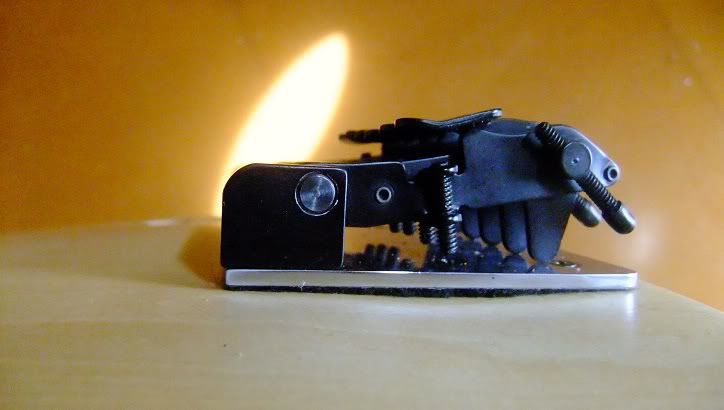 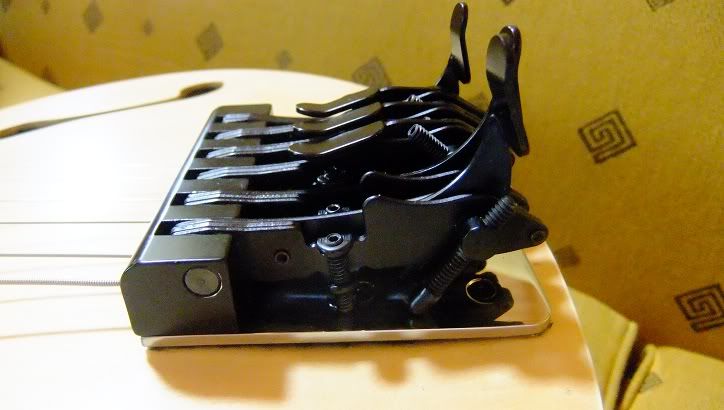 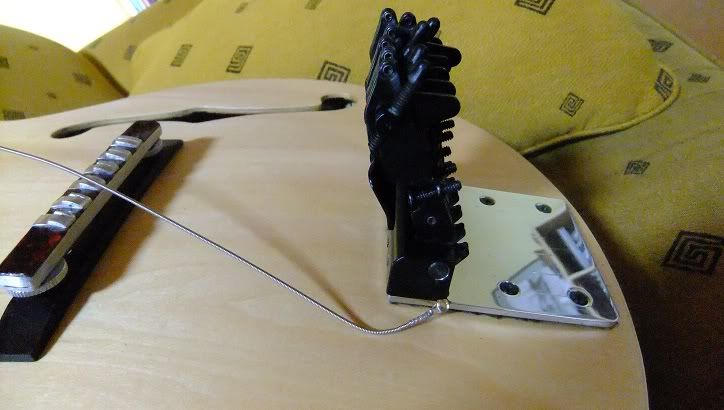 These pics might give an idea of how the thing operates and how to string it in the last pic... ... TuningsFor this guitar, I have it tuned to standard tuning and lower all strings in half steps form there, but there is a fair range depending on string gauge...this seemed to make more sense for me and what I want to do with it. So, E standard...dropped D is instant and accurate and no problems at all, could be done mid song very quickly. I still need to re-adjust everything with the action change and all, tuning everything down to Eb is a bit 'loose' hendrix style but can be useful as I need to use a lot of open strings and this is like a reverse capo and the looser strings make bending and such easier. You got to watch that you don't play too hard as the strings can hit rattle about if not careful. It does give the guitar a different sound though, so a bonus. Everything down to D is perhaps a bit loose really. However, the idea here is that by lowering the E, A and high E all the way you get open G and that works fine. Drop the E, high E and B strings gets you DADGAD popular for celtic type arrangements. Potentially you could get open D I suppose ...ummm... D,A,D,F#,A,D...perhaps you might find a use for a 'raised E like tuning...say F,A,D,G,B,E (but in Eb)...something like this can be good for an Am to F ride outs and solos where you want an open string in the bass there...say for soloing over the end of stairway LOL! Anyway, for the moment, this seemed to be the most useful, did not raise any strings and was not so extreme that things are going to get too floppy or break anything....and suits my purpose. Other people may have more elaborate tunings and I have a few arrangements that are alterations of such things...but then, that's what tuners are for. You might have to retune one string perhaps but the trilogy takes care of the rest pretty well. SO, I'm pretty impressed. I've not been an opened tuning guy before so a lot to learn, but having it instantly there certainly encourages it. Players like J Page a P Townsend in rock of course made some fine use of such things and just exploring the unfamiliar can make you come up with some interesting things when you get in a rut and then you can work out how to do it in standard perhaps. ... It is not necessarily a 'smooth' transition with this set up. The cam system uses the strings pressure to hold it in place, so there can be a lift then drop in pitch...so it is not really pseudo string bender or anything. As I am trying to do some involved finger style solo guitar, my right hand is typically too busy to be messing with such things in the middle of a tune...not quite suitable for the kinds of things that A. Legg does with his banjo tuners, but infinitely more practical. This guitar is unusual in that it has a long fender scale and so tighter string tension (also a wide string spacing at the bridge, more like an acoustic for right hand technique) and a long length of string behind the bridge...if fact the high takes the full uncut string less perhaps an inch or two...so a very 'long' guitar there. There are some hidden bonuses there, you can for instance easily bend strings behind the bridge individually for b-bender like effects. One could create a little lever there to be accurate in this pitch, more like a pedal steel, but the finger will do it quite well. Again, this guitar is designed to play solo stuff...so the melody, harmony and bass lines...but this trick can be useful for bending a note within a chord say. It is also great for bending open string harmonics. One can easily make a little 'cadenza' type of thing with the 12th and 7th fret harmonics in G major and bend the F# (b string, 7th fret) a half step for a nice high G and resolve that tension there... I think I will need to find a way to hide the tiny allen key to adjust it in the guitar though, just in case, but all seems to hold pretty steady. Still early days and I don't expect it to be able to do everything...but it certainly is worth it for the things it can do and use all the time in this style like dropped D and open G... Possibly not good if you use super skinny strings to drop them any further and if you like a super low action, there may not be the room for them to vibrate freely. So consider that perhaps. Test your guitar by simply retuning and see how the other strings react and if your set up preferences can handle such capabilities. ... The purpose of the Hex system is to expand things further with this style. By doubling the lower strings down an octave, one can use a very high capo say yet still have extended bass tones. And other effects. When starting out on this style of playing this year and studying a range of players, I did notice that the guitar tends to favour certain keys (for open strings) and generally sharp ones like E and G and D and A. The ear can get tired of such things. Also, there are only 6 string and your left hand can only stretch so far and so the range is fairly restricted and in the tenor range. I was impressed with Pat Metheny's recent solo work on his baritone. This guitar is tuned down but standard, but the inner two strings are an octave higher than the rest...so a weird kind of 'nashville tuning'. The result is a lot of range and some interesting arrangements. He says he thinks of it as three two stringed instruments and you can kind of see that in the way he plays it. This clip you can clearly see how this works...towards the end is a normal classical for one track, and his weird manzer 42 string guitar...for when you cant modify the guitar too much LOL. ... Hex and other adventuresSO, the tuning system and the hex ideas are drawn from that, but the guitar would be great (and a lot cheaper) without all that. You don't really need a trilogy to retune the guitar, but with it I am most likely to do it and live it can be done without a thought. I will post clips, but this is an interesting guitar in sound. It certainly has an acoustic quality, but in the vein of an arch top, not your usual 'strummy' flat top sound. The mag pickup is suitably 'woody' in character with a bit more body and the combination really smooths out the 'piezo' high end. So, you can have a nice warm sound in the bass and still get all those high end details and harmonics. You could play anything on it really, bar shredding I suspect. This is mainly due to the thick strings and medium high action I prefer on all my guitars as much as anything. I chose this string gauge to give a stiffer feel in the bass, but I always use tens on top so bending strings is not an issue. It gives a pretty full bodied sound though, but you can get high end on it for more fender-y type things with the piezos and parallel switch to back things off without noise. Things like the 'dark' switch are interesting as it gives quite radically different tone between the mag and piezos and you can blend out of an 'acoustic' like sound into the full, muffled jazz box things should you chose, or select it at the flick of a hidden switch. ... As you can see, there has been a lot of thought into this instrument and I am really grateful for john and others who have entertained what might have seemed a little too pedantic, even for me LOL, in getting it to work as I intended and even improving some of the functionality as with the stereo switch. There are a lot of really interesting possibilities with the stereo thing, even without dual amps, dual effect chains and this kind of blend can give you some degree of on-board control over thing which can be pretty cool and could see it suiting many styles (say blending between a clean pickup/effects through to a distorted sound...even in mono. And I do hope that it encourages people to look even further ahead and into what they want an instrument to do and function and really pursue that. Modding guitars can be really rewarding and while there is a lot one can do with wiring which is the speciality here, there are lots of things one can do with set up and adapting instruments without 'literally' building such things. There were not too many 'specialized tools' used here, I have no workshop if it rains and almost everything was done on my dining table to be honest....lucky I generally live alone, ain't it!
|
|
|
|
Post by cynical1 on Dec 26, 2011 11:17:46 GMT -5
Amen. There are two types of neck\neck pocket interfaces...those with shims, and those that need it. Rarely have I seen a perfect union directly from a manufacturer to a players setup or style.
[soapbox]
Think wood veneer. It starts out thin, is sandable, can be fashioned to cover the entire neck pocket and if it's a hardwood veneer it will not compress.
[/soapbox]
There are more then a few companies offering InkJet or LaserJet waterslide decal transfer sheets. Any vector based graphics program can be used to generate your artwork.
Print it out at the highest resolution available, coat it, let it dry, cut it and apply. Same same as decals for model airplanes...if you guys had that down there...not sure if the model kangaroos came with decals...
And you can leave the existing decal there and just add yours to the neck. Wet sand with a 400 grit to smooth the face of the headstock and remove any rough spots first and you're ready to apply your decal. I never removed a builders decal on rehabs I did, I just added mine to it.
A little poly mixed 50\50 with mineral spirits and wiped on will seal your decal in place for the ages. If you want to flush the decal be prepared for a lot of wipe on coats and sanding, but the results are seamless when you finish.
Let it sit for a few weeks, wet sand and buff it out and it looks like it came that way from the factory.
Trinity
And that was an interesting find on the Pat Metheny video. Always been a big fan and will need to find this one.
And guerrilla building\modding is not impossible, as you have shown. I'm working much more lean and mean then I used to. I will be working on building the arsenal back up again over the next few years. Having had the tools previously does tend to spoil you and consistent results are markedly quicker to attain.
The tools just make the job easier. There are always workarounds as necessity is somebody's mother...
Again, very nice job.
Happy Trails
Cynical One
|
|
|
|
Post by asmith on Dec 26, 2011 11:53:30 GMT -5
I really must find the time one of these free afternoons this week to read this thread all over again from page one.
From the little I've dipped into it - as I really couldn't have / still can't contribute anything technical to this project - it's been an admirable and inspiring display of craftsmanship, ingenuity, and balls-out willingness to get it done. I've often marveled at your power to stick with something like this and devote enough time in your days to it, not just this project but others as well.
Utmost congratulations on your build.
|
|
|
|
Post by reTrEaD on Dec 26, 2011 12:06:38 GMT -5
These pics might give an idea of how the thing operates and how to string it in the last pic... Yes, they certainly do. Thanks. There are a lot of misconceptions about "straight pull" headstocks. Might be worthy of a mythbust at a later date. |
|
|
|
Post by lpf3 on Dec 26, 2011 12:08:02 GMT -5
From the little I've dipped into it - as I really couldn't have / still can't contribute anything technical to this project - it's been an admirable and inspiring display of craftsmanship, ingenuity, and balls-out willingness to get it done. I've often marveled at your power to stick with something like this and devote enough time in your days to it, not just this project but others as well. . I just logged in to say exactly that , but asmith put it into words very nicely. I haven't been able to offer anything intelligent to your thread but I've been watching it in silent awe. +1, and thanks for adding to the knowledge base. -lpf3 |
|
|
|
Post by JohnH on Dec 26, 2011 15:28:23 GMT -5
The whole unit looks great, and I'm delighted to have been able to contribute to it. We are all grateful to 4real for letting us follow step by step.
Since the current (never say final!) circuit seems to have more legs than hairs on it, I might post it on my thread about the modules that its based on - otherwise it might get lost, being 13 pages forward from the start and already 3 pages back!
cheers
John
|
|
|
|
Post by 4real on Dec 26, 2011 15:28:43 GMT -5
Thanks to all sincerely... Perhaps even more interesting things are yet to come with a third pickup system that can output selected strings...but that will take some extra time to develop I imagine and the guitar does not 'need it'... Any namign and perhaps decals and such can come later I expect. Even though the guitar exists and have been playing it abit along teh way, there is always a little 'tinkering' along the way. Building the thing though has taken quite a bit away from the playing side of things... I really appreciate this, thank you. I'm trying to take the same approach to my new aspirations in music of which this guitar is a product and in many ways symbolic. It's been a fairly personal project to set out to make something that explored a lot of things that have been in my 'system' for ever (like the use of alternative materials like the ABS plastic back, etc) and making a bit of a bridge between acoustic and electric styles of playing and combining the new with the traditional side of things without alienating anyone in the process. ... I'm sure there are many mis-conceptions in a lot of things LOL, it just takes some time and experimentation to get them ironed out perhaps. ... Veneer might not be available...but we will see what it needs, it wont be much. The action is perfect on the lower frets and it needs a bit of space...I tend towards wanting my guitars to 'fight back' a little. I had a little look around at decals, but it can wait. This neck came off my first decent strat I got at a pawn shop a few decades ago when I switched from my real LP that I played for the longest time. I've put a lot of time on it over the years and it's a little like 'coming home' in some ways...though a little 'skinny' in width for my taste, most things are. Some may notice a bit of an optical illusion on things like action. I widened the bridge / string spread as much as I could and still fret the strings before the bevel on the ends of the frets and this give the look of the action this kind of thing. ... There is a lot packed into this guitar and it's concept but to me, it is a bit of a concept guitar (although this is going to get hundreds of hours over use I am positive) and in my imagination, I can see the concept being refined even further and perhaps some future day I'll make something more along those lines drawing from my experiences on this one and where the music takes me. It's far from 'perfect' and if I can justify it one day, it would be great to throw some money at making something closer to that. But, it certainly performs well and seems pretty fail safe. I have certainly learned a lot, this is my first 'active guitar' and I can see quite a bit of potential there. ... Musically, guitaristically I've not been 'excited' by too many guitar players these days in the electric guitar field...might just be growing old, might just be a phase music is going through, might be my own circumstances of not having the opportunity to play with others perhaps... But...in the solo guitar field there are dozens of astonishing players and techniques...true a lot are acoustic players and I'd like to combine the power and bravado that an electric guitar allows with this idea. Far too many to mention and no one player says it all...all the players at "candyrat" records have something unique for instance... Andy McKee, Ewan Dobson, Don Ross...the list goes on with unique approaches like thing kind of thing but acoustic or electric players alike... An approach like Andy Mckee takes what one can do on six strings to another level really...and his sound just one approach... Someone that I am learning a lot from and in part an inspiration for this guitar is Jake Reichbart...and a really nice guy all round... Very much that 'acoustic/electric' mix and a great player, arranger and teacher...I'm trying to learn as much as I can from this guy especially his unusual 2+4 backbeat strumming thing which is slowly coming along. Got your bass, melody, harmonies and other details all working together... Shaun Murry is another inspiration on me and learning a few of his arrangements as well...amazing arranger and really nice guy and the most convincing arrangement of this 'stunt' song including the guitar solos LOL... There are few electric players playing with this kind of thing, perhaps it needs a new instrument to make the most of it  but this guy has got a fair bit of dexterity though the traditional electric lacks something in the tone...though it's all there on six strings if you can find it... ... Anyway, a long way to go to get to that kind of level technically and to find my way, but there are so many ways to make an effective tune on the six strings with a bit of inventiveness and ingenuity and determination and of course time... The purpose of this guitar was largely in an attempt to get a bigger fuller bodied sound than many of these players, and visually and sonically bridge a gap between the electric and acoustic world and audiences. I really have had experiences where the look of an instrument has a lot of an effect on the perception and this guitar aesthetically covers most bases there and 'acceptable' to most. I do regard it as an electric guitar though and that is where the sound is so these later stages have been important to bring this potential out of it. One of the things I thought lacking in a lot of these players is the inability to change textures as much as a guitar is capable, or the range and depth of sound that is available to a real 'band' or even a solo piano player. It can sound a little same-y within the song and parts as well as between song to song. The hope for this guitar and further developments is to address that still more while not radically changing the format of the instrument itself too much. ... Anyway, a few thoughts on what inspired this instrument and what I want to do with it though it is perfectly at home with any kind of playing really and a nice compliment to the LP, strat and tele around the house... |
|
|
|
Post by 4real on Dec 26, 2011 15:50:25 GMT -5
The whole unit looks great, and I'm delighted to have been able to contribute to it. We are all grateful to 4real for letting us follow step by step. Since the current (never say final!) circuit seems to have more legs than hairs on it, I might post it on my thread about the modules that its based on - otherwise it might get lost, being 13 pages forward from the start and already 3 pages back! cheers John Absolutely John, and a big thanks to you on this aspect of the project...would mean nothing if it didn't sound good. The dip in the blend with the added resistors is a little annoying, but that can be returned to the previous scheme...it might be of benefit in stereo mode where you have too amps running both systems anyway, so will reserve judgement for a while yet. I can report that other than the piezo hiss when run at EQ extremes the buffers and whole system is completely quiet which was important to me. It has made me reassess my avoidance of active systems for sure. Part of the quietness comes from some extreme shielding I suspect, but then the electronics added nothing extra to things, perhaps improved things further. I'm really glad you 'pushed' the stereo switch thing as this will be very useful and so gave it it's due easy reach location on the guitar. I really think that there is a lot in this kind of scheme for all kinds of players and guitars and people might like to consider the possibilities of such a radically different approach whatever style of music one plays. The piezo system is completely optional to such things. It does not even need to be 'stereo' with multi amps though this is very effective. Dual effect chains means that with one control one can mix between or combine them in really interesting and no fuss ways right from the guitar. You could do all kinds of things with it, like record a highly effected 'live' guitar while also recording directly a direct signal out of the guitar and mix or model that simultaneous 'take' after the fact to your hearts content if the performance is good, but the sound turns out to be less than stellar as it felt in the moment. With this scheme of course, it is not an either or proposition either, it is perfectly happy and effective running in mono with a conventional single lead. So, a few quirks in it, but it does work very effectively...and again, thanks...glad to have been able to make it happen and do your work justice!  I certainly hope that others will not require 13 pages to make such a thing work in the future, I learned a lot...but a good proportion was working out how to build the guitar itself and following a lot of blind alleys along the way...next time and for others it will be a lot easier I'm sure. A real tribute to the forum and all the members here to help me realize my own vision and stick with it over quite some time...cheers to all! |
|
|
|
Post by sumgai on Dec 27, 2011 4:26:05 GMT -5
I certainly hope that others will not require 13 pages to make such a thing work in the future.... Now why am I suddenly reminded of a certain thread that covered the building of a sustainer, and run to something like several thousand posts?  |
|
|
|
Post by 4real on Dec 27, 2011 5:43:40 GMT -5
Well there was and still an interest in such things, as is this project....I think that thread got to about 5000 but then, that's a thousand less than the number of posts by you alone there sumgai.
I only really make a guitar a year perhaps but when I do, I try and put everything into it and make it unique...I did notice that most of my threads here has garnered quite a few views and I am sure it is not in awe of my verbosity or ability to type...
Don't worry, the guitar is working and I have stretched my abilities in doing it and I am sure that this guitar will satisfy for what I am seeking to do with it for a long time yet to come.
There is a lot more to doing this than wiring alone, especially this guitar that went far beyond my usual modding of things or focus on a single component. A lot of this project was in building a comlete guitar, not elongated problems completing an established scheme or reinventing the wheel after all.
I hope that I does inspire people to do similar things, perhaps take a few from this or come up with some more interesting ideas...again I thank all and the forum for allowing me to share these things. I do of course direct any queries to this forum and I know that there have been a few people that have been drawn here from hearing about this project, just as there were an incredible amount directed to that other forum for hosting the sustainer thread, and surely that is not a bad thing, other than for myself who is providing content and doing the work, no?
I got to play the guitar for a good 6 hours today, it is so easy to get lost in a new instrument and but for a few quirks, it is doing what I envisaged for it and will significantly change the way I play and approach the instrument...that's a lotta guitar. For a while there, I was considering just buying something, but it would have cost a lot more and not do 1/4 of the things this thing can do. I think that is a large part of what we all try and do here, to really personalize our instruments and better achieve what we want from them.
|
|
|
|
Post by 4real on Dec 28, 2011 8:12:47 GMT -5
Hmmm...left the guitar plugged in overnight and the battery went as flat as a tack. There is a bad 'squeal/squark' when you plug the guitar in to a live amp...likely the power going on I guess...might need an 'on/off switch after all. Any thoughts on this?
I'm thinking of taking out those 220K resistors to next chance I get...helped teh volume control a bit, but sacrifices a little too much of the centre of the blend unfortunately...
I might need to get a roller tree for the high strings...my new technique uses this unusual back hand 'strum thing'...kind of a flick of the wrist so that the back of the nails hit the strings, often quite forcefully...and the high E pops out of the nut occasionally...LOL
|
|
|
|
Post by reTrEaD on Dec 28, 2011 8:55:44 GMT -5
Hmmm...left the guitar plugged in overnight and the battery went as flat as a tack. There is a bad 'squeal/squark' when you plug the guitar in to a live amp...likely the power going on I guess...might need an 'on/off switch after all. Any thoughts on this? If you have the cable plugged into a live amp, then plug into the guitar, the noise is probably caused by the tip of the cable momentarily making contact with the ring (battery) connection of the jack. A switch (in addition to, not instead of power switching at the jack) won't necessarily be a bad thing. But it's not as visual as unplugging the cable. You have to remember to switch off. And if in the wrong physical location, you might accidentally turn the power off when operating one of your other switches. I might need to get a roller tree for the high strings...my new technique uses this unusual back hand 'strum thing'...kind of a flick of the wrist so that the back of the nails hit the strings, often quite forcefully...and the high E pops out of the nut occasionally...LOL String tree? Ew. Shim your neck first. The slight increase in angle when you lower the action might be enough to keep the high E in place. If not, do what ya gotta do... |
|